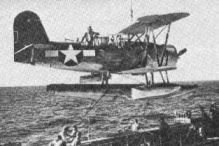|
The bars now limited visiting servicemen to a couple of drinks at a sitting and then you had to leave the establishment. Lines leading to stores, gift shops, restaurants, houses of ill repute and tattoo parlors consisted of men of all ranks and all services. Officer and enlisted alike were required to observe no line-jumping protocol. If you got in a line you often werenít sure if it led to a house of ill repute, bar or tattoo parlor.
Not wanting to stand in line, Jake went to Waikiki, saw a movie, had a hamburger and milk shake and then went back to the ship as curfew was at 6PM when all service men were required to be off the streets. Blackout went into effect at dusk and if you werenít back the Military Police or Shore Patrol would bring you back.
The Swayback Maru left on her third war patrol 11 January, 1942, with Task Force 8 consisting of eleven destroyers, four heavy cruisers (Northampton, San Francisco, Chester and Salt Lake City), aircraft carrier Enterprise and tanker Platte.
The first several days were spent firing and checking out our guns during which C.F. Tyler was accidentally caught in an ammunition hoist and fatally injured.
We crossed the equator at 2117 HRS the same day, 15 January, still not knowing where we were headed but Task Force activity was increasing. The next day Jake was on watch at his battle station, the aft starboard quad mount 1.1 pom pom anti aircraft guns all day. The Enterprise crashed one plane on deck and another couldnít find its way back. A third plane landed in the water but the crew was rescued.
Lieutenant D. S. Crowley and C. W. Morgan, ARM1c left January 19th on a mission in one of the shipís scout observation planes and did not return. The next day 
 James W. Davis, Jr., Ensign and Edward R. "Reg" Howard were sent on another mission and also didnít return. Both airplanes returned a couple of days later. It was later revealed that they went to Pago-Pago for guard mail and patrolled around the Samoan Islands. Morgan later told the story of going into Pago-Pago and digging up 55-gallon drums of aviation gasoline, which had to be filtered through a chamois skin to remove the water prior to the refueling the plane. The aviation gasoline had been buried after a Japanese submarine bombarded Pago-Pago and most of the Navy personnel had been removed. It was a strong possibility they would try to take over and use the sheltered harbor at Pago-Pago for a sea plane base to more effectively prevent supply convoys from reaching Australia and other South Pacific allied bases.
James W. Davis, Jr., Ensign and Edward R. "Reg" Howard were sent on another mission and also didnít return. Both airplanes returned a couple of days later. It was later revealed that they went to Pago-Pago for guard mail and patrolled around the Samoan Islands. Morgan later told the story of going into Pago-Pago and digging up 55-gallon drums of aviation gasoline, which had to be filtered through a chamois skin to remove the water prior to the refueling the plane. The aviation gasoline had been buried after a Japanese submarine bombarded Pago-Pago and most of the Navy personnel had been removed. It was a strong possibility they would try to take over and use the sheltered harbor at Pago-Pago for a sea plane base to more effectively prevent supply convoys from reaching Australia and other South Pacific allied bases.
We cruised around the Samoan Island of Savaiíi and then headed northwest toward the Marshall Islands, entering waters where Japanese submarines would be operating. The weather became rough and on the third day it improved but the destroyers picked up submarine contacts several times on their sonar which caused us to be at general quarters on torpedo defense most of the day. Finally late that afternoon one of our destroyers reported sinking one; however, we remained at general quarters until an hour after dark.
The next morning a large enemy plane passed about 40 miles astern of the Task Force but it did not deviate from its course. Therefore the Japanese crew must have not been looking and we didnít want them to know about our presence in the area, so no attempt was made to go after it.
That night the Task Force continued northwest across the International Date Line rendezvousing with two fleet tankers at daybreak. The Salt Lake City refueled the destroyers McCall and Dunlap, then was refueled and received welcome mail from the tanker Platte. After refueling Captain Zacharias informed the crew that we would carry out the first offensive action of the war against Japanese territory in the Marshall Islands at daybreak February 1, 1942.
|
